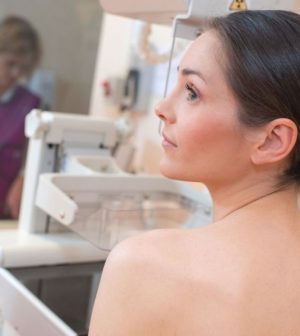- How Savvy Habits May Help Head Off Dementia
- HHS Launches New Autism Study Despite Experts’ Concerns
- CDC Urges Extra Measles Shot For Some U.S. Travelers Amid Outbreak
- Showerhead Water Limits Rescinded as Trump Targets Household Appliances
- Most Women Aren’t Clear When Menopause Might Start
- New Visual Test For Autism Could Aid Earlier Diagnosis
- Half-Million Children Could Die If U.S. AIDS Relief Is Dropped
- Seasonal Allergies Likely To Grow Worse Under Climate Change
- First Baby Born From Robot-Controlled IVF
- Eviction Bans Linked To Drop In Child Abuse Reports
Mammograms Helped Save Up to 600,000 U.S. Lives Since 1989: Study

Widespread mammography screening and big advances in breast cancer treatment have saved hundreds of thousands of American women’s lives since 1989, a new study estimates.
Researchers tracked 1990-2015 U.S. data on breast cancer deaths, along with general data, on women aged 40 to 84. They found the number of breast cancer deaths prevented during that time ranged anywhere from 305,000 to more than 483,000, depending on different approaches to interpreting the data.
They then extrapolated those results out to 2018, and calculated the number of breast cancer deaths prevented since 1989 at anywhere from 384,000 to 614,500.
In 2018 alone, between 27,000 to almost 46,000 breast cancer deaths were prevented, the investigators said.
The findings should help reassure women who wonder about the value of mammograms, said study author R. Edward Hendrick, of the University of Colorado’s School of Medicine in Denver.
Recent studies “have focused media attention on some of the risks of mammography screening, such as call-backs for additional imaging and breast biopsies,” he said. But those reports have also often neglected “the most important aspect of screening — that finding and treating breast cancer early saves women’s lives,” Hendrick said.
Mammography screening first became widely available in the mid-1980s. The new study estimates that regular screening plus improved treatments cut the expected rate of breast cancer death in 2018 by between 45 to 58 percent, according to the study published Feb. 11 in the journal Cancer.
“Our study provides evidence of just how effective the combination of early detection and modern breast cancer treatment have been in averting breast cancer deaths,” Hendrick said in a journal news release.
One breast cancer physician applauded the new research.
“We have new immune therapies and improved surgical techniques that are important advances against breast cancer,” said Dr. Alice Police, who directs breast surgery at the Northwell Health Cancer Institute in Sleepy Hollow, N.Y.
“However, the biggest factor in literally centuries to lower the mortality rate from this devastating and extremely common disease is the humble screening mammogram,” she said.
“Nothing else in detection or treatment has even come close.”
But Hendrick noted that only about half of U.S. women older than 40 get regular mammograms.
“The best possible long-term effect of our findings would be to help women recognize that early detection and modern, personalized breast cancer treatment saves lives, and to encourage more women to get screened annually starting at age 40,” Hendrick said.
Dr. Kristin Byrne is chief of breast imaging at Lenox Hill Hospital in New York City. She agreed that, in keeping with guidelines from the American Cancer Society, women aged 40 and over should consider getting regular mammograms.
Byrne said the new study “is further evidence that early detection and improved treatment saves lives.”
“Over 335,000 women were diagnosed with new breast cancer in the United States in 2018,” she noted, and “eight out of ten of these women have no family history of breast cancer. “
According to current American Cancer Society guidelines, “women ages40to44should have the choice to start annual breast cancer screening with mammograms [X-rays of the breast] if they wish to do so. Women age45to54should get mammograms every year. Women55and older should switch to mammograms every2 years, or can continue yearly screening.”
More information
The U.S. National Cancer Institute has more on breast cancer.
Source: HealthDay
Copyright © 2025 HealthDay. All rights reserved.










